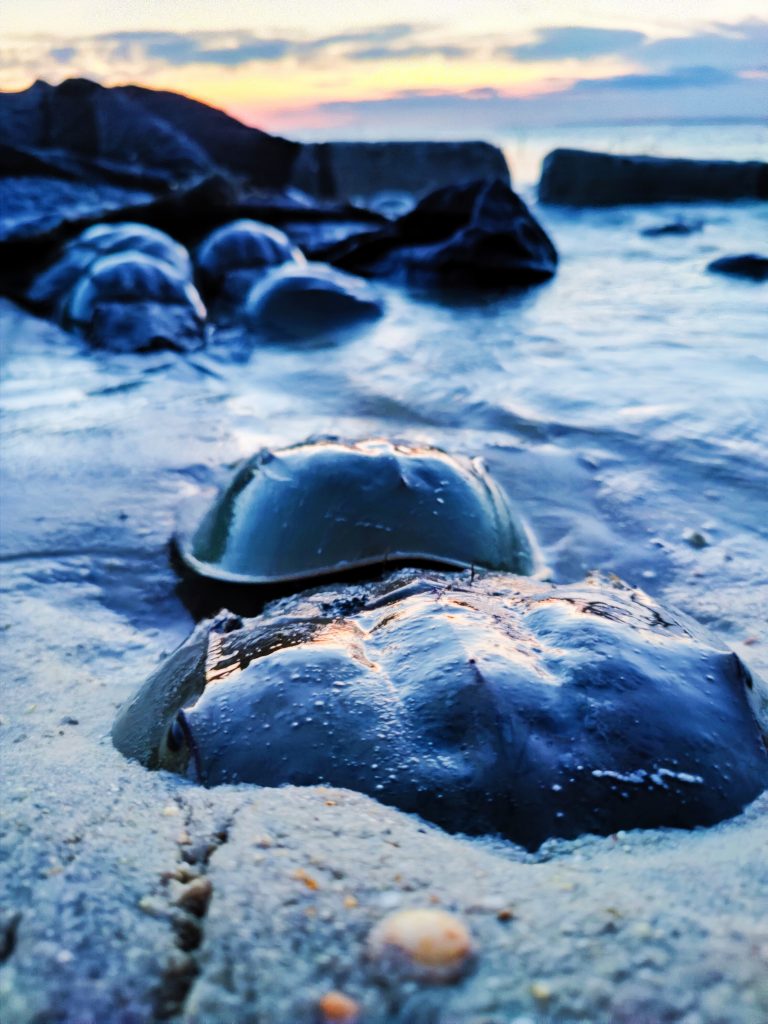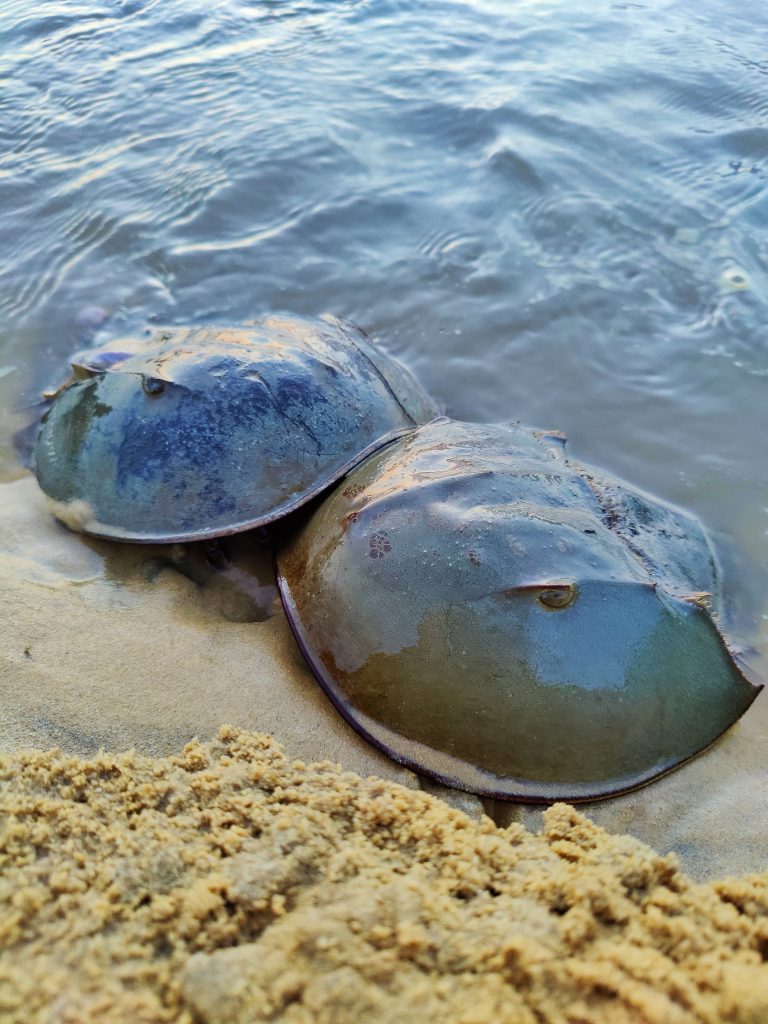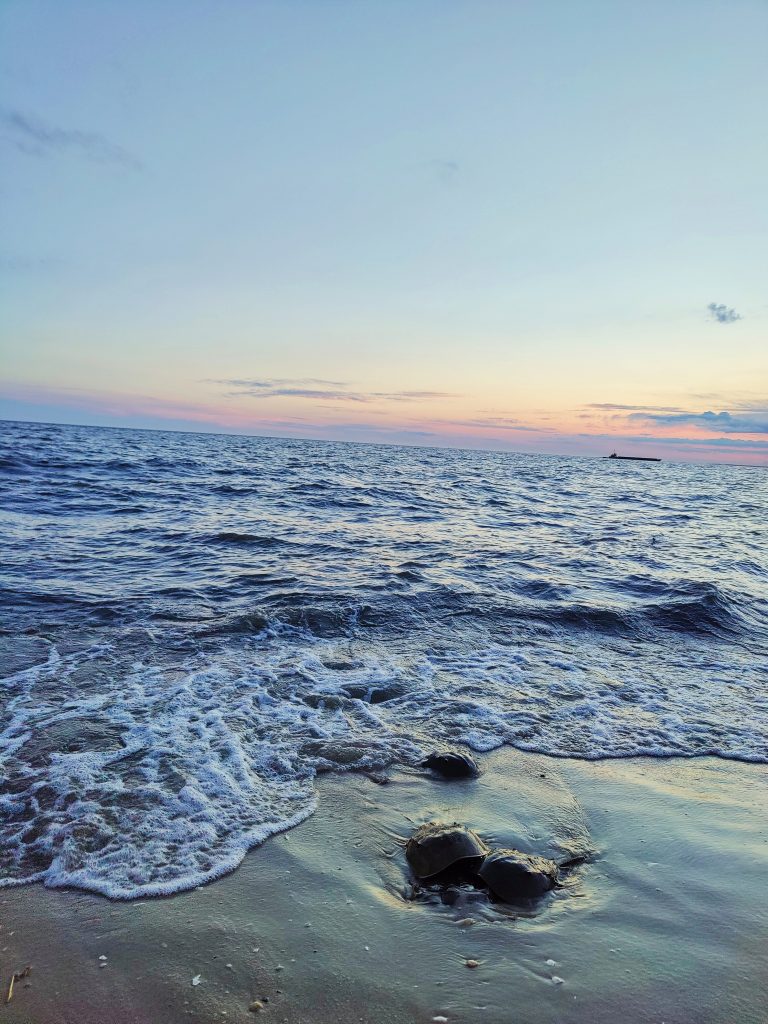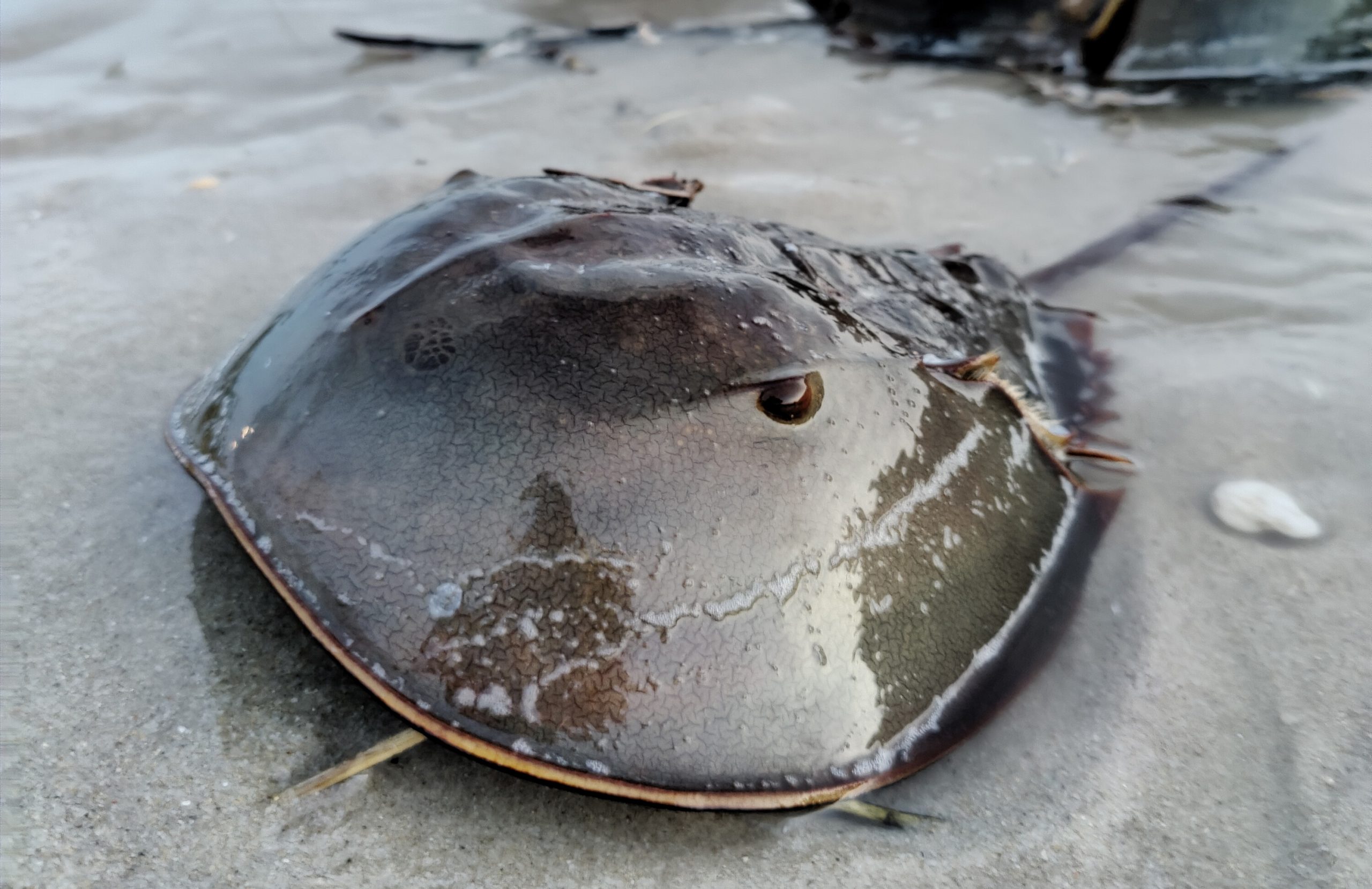If you got a COVID vaccine, or any vaccine—or really any medical intervention over the past several decades—you can be sure that the blue blood of 450-million-year-old prehistoric arthropods known as horseshoe crabs was used to keep you safe. But in the U.S., lurking behind this magic potion is a fragile industry stubbornly dependent upon the traumatic bloodletting of a vulnerable species, compounded by a sea of red tape thwarting the widespread adoption of a viable alternative.
I have a bundle of murky memories of visiting the Baltimore Aquarium periodically with my grandparents as a youngster, but vividly I remember two things: laughing with glee while being splashed by a wall of water at the end of a dolphin show (which I now, regretfully, reflect upon much differently: from the dolphins’ perspective of perpetual captivity); and being horrorstruck when a horseshoe crab in a touch tank was flipped over, revealing what appeared, to my 7-year-old self, to be hundreds of sharp robotic claws.
My grandparents told me to go on and touch him. So I extended a finger slowly like E.T., just barely making contact with the shiny surface, and then recoiled with a shriek. Thus marked the beginning and end of my childhood foray into hands-on horseshoe crab encounters.
Until this year, at age 34. I was planning to visit a friend in New Jersey this past June and remembered having read recently that these crabs (who are really more closely related to spiders than actual crabs) congregate annually on the shores of the Delaware Bay, home to their largest population in the world, to spawn and continue on their ancient species. Google Maps told me my friend’s place was just under an hour from the nearest hotspot. I had also read of the role these living fossils’ blood had played in concocting vaccines during the COVID-19 pandemic, a fact that plunged me into an ethical quandary: I knew we desperately needed the shot, but I also knew that the “bleeding” of horseshoe crabs left me feeling oddly seasick. Ultimately, then, I knew I had to make it there to witness them, the beings to whom we owed our life-saving intervention, in order to process my inner tsunami.
In advance of my trip, I dove into researching just how, exactly, to maximize my chances of spotting horseshoe crabs in this pivotal act that has kept them surviving, without evolving, for eons. They aren’t just hanging out on any beach at any given moment. Each May and June, these magnificent beings appear in vast numbers on the shores of the Bay only at the evening high tide, and most abundantly during the full and new moons. Thus, the best time to spot their gatherings with enough daylight is on the few days of the month when sunset and high tide collide, within a few days of a full or new moon. It took my human brain an entire hour of matching up tide, sunset, and moon charts to pinpoint that sweet spot. I have no idea how these creatures make all of these calculations themselves, except that they must have unlocked some sort of ancient wisdom unbeknownst to our species.
After wrapping up a fun weekend with friends, I chomped down a vegan cupcake from Wildflower Vegan Café in Millville, New Jersey, and set off. As I drove down the lengthy road toward the East Point Lighthouse, a popular crab destination, I noticed my cell phone losing signal. My battery was hovering around 7 percent, the GPS sucking up all the juice my car charger had to offer. The sun was sinking lower into the sky. I knew I had mere minutes to arrive with enough light and enough cell phone battery to capture the spectacle. The road suddenly came to an end almost at the water’s edge, and I slid to a stop. I scampered over the dune, clasping my Canon camera and cell phone in each hand, hoping at least one would succeed in documenting the magical moment. There were several other people dotted about, lured by the vibrant hues of the sunset against the lighthouse. But I looked downward.

Immediately, I saw them, a group of greyish brown helmets playing bumper cars in a relatively calm pocket of water by the shore. I knelt down and, fingers shaking, started snapping photos furiously between my phone and camera, aware that it was the only chance I would have for the remainder of the season when sunset, high tide, and the eve of the full moon would all align. Through my lenses, I watched as the crabs tangoed together, males sliding up on females’ backs for their chance to pass on their 450-million-year-old, virtually unchanged DNA. Then a wave would pass, separating the pairs and leaving them to swim in circles again to resume the act.
I bent down for a clearer look. The entirety of their visible, above-water bodies, or carapace, comprised two connected, smooth structures, bending at the middle joint—plus a rigid tail jutting out of the rear end. Bordering this tail, on each side of the posterior shell, was a row of spikes. And seamlessly embedded into the round front shell were two deep brown, hard pearls—their eyes. They did not blink or move; there were no corneas or pupils. Yet, somehow, they stared back at me. As I moved my lens toward them, they’d slowly steer away.

The sunlight retreated as I walked along the shoreline atop a geotube. The Bay waves crashed with more fervor here. Clumps of horseshoe crabs attempting to spawn were knocked about, flipped around, and jettied back and forth. They were at the mercy of the sea, carried by its unrelenting movement. Were they relying on luck to eventually float them into less violent waters? Somehow, this strange methodology has worked without modifications for hundreds of millions of years. Despite eroding shorelines and rising temperatures, these crabs resist change, century after century, millennium after millennium. They stagnate in an apparently already impeccable state; it’s only the world around them, our world, that has evolved, unleashing troubled waters.
I reached a tiny inlet, where water had dug a channel into the sea grass, and the stench of rotten seafood met my nostrils. Upon their retreat back to low tide, the Bay had left dozens of flipped-over horseshoe crabs behind to die. I took in the sight over their undersides, the complex joints and appendages that were normally hidden underneath their sturdy shells. Their legs, wielding those alien-like pincers that had intimidated me as a child, pointed upwards, motionless. Here, they now fascinated me, a relic of a time long before I, or any of us, had ever been conceived. Plus, as an adult, I now knew they posed no threat. Alien as they seemed, these “claws” do not pinch; they simply swim and dig, the instruments that carry the crabs through their underwater realm.
I carefully stepped around the upside-down crabs and poked their bodies with my toes, one after another. All dead. Then, one began to move her legs like a claw game in an arcade. I reached down and carefully flipped her over just before the next wave approached. Slowly, she pushed herself back into the water and was joined by one of her peers. There was no time to reflect on her near-death experience; only to complete that singular mission of carrying on the species.
I sat on the geotube, filming as the final rays of sun were overtaken by moonlight. In those 30 minutes, I saw dozens, maybe hundreds, of crabs flipped around by the waves. Any who were left on land flung their rigid tails up and down, bucking their bodies and waving their legs frantically. Through this series of motions, most were able to right themselves without help. Their peculiar methods, again, worked.
By the time I packed up to leave, everyone else who’d come for the sun’s glorious exit was long gone. I drove back up the dirt road with 4 percent left on my phone battery, begging my signal to return and chart my course home. But the surrealness of the experience lingered; awe rushed over me and calmed my nerves. I’d just seen a process that originated long before humankind, and that somehow persisted, just as it always was, through the birth and death of the dinosaurs, alternating ice ages and interglacials, and the rise and fall of emperors and dynasties.

But now, their species will either sink or swim in response to perhaps their greatest threat yet: modern man.
The decline of the American horseshoe crab, also known as the Atlantic horseshoe crab, began decades ago, first spawned by the roundup of millions of crabs to be ground up into fertilizer in the early 1900s, and then exacerbated by overfishing for bait (used to catch other fishes and sea snails), as well as strandings on man-made structures. By 2002, there remained only just over 300,000 individuals left in the Delaware Bay, down from over 1 million in 1990.
The most calculated, organized, and enduring assault on horseshoe crabs in the 21st century, though, has been that thing that propelled my visit to the Delaware Bay in the first place: horseshoe crab bleeding for human medicine. Scientifically (or at least pharmaceutically) speaking, their blue blood is pure gold—to the tune of about $60,000 per gallon. The clotting agent unique to horseshoe crab blood is used to create Limulus amoebocyte lysate (LAL), which is instrumental in modern medicine because it detects endotoxins—deadly poisons to the human bloodstream. Today in the United States, crab-derived LAL is the nearly universal tool used to protect vaccines and other medical equipment from these toxins. Every single childhood shot, every intravenous drug, dialysis equipment, insulin, medical implants, and yes, every single American COVID vaccine, were brought to you by horseshoe crabs. All in all, LAL has evolved into an approximately $100 million industry in this country alone.
Among the Atlantic horseshoe crab’s cousins, the Chinese horseshoe crab was recently classified as “endangered” on the International Union for Conservation of Nature and Natural Resources (IUCN) Red List, owing to intensive harvesting by the medical industry in Asia, and now conservationists worry that the American species isn’t far behind. Here, since their crash in the early 2000s, populations of the American species had somewhat stabilized, thanks both to nonprofit programs like reTURN the Favor, whose volunteers patrol beaches and flip over thousands of stranded crabs, as well as legal protections, like bans on the capture of female crabs for fishing bait. Such regulations, promulgated by the Atlantic States Marine Fisheries Commission (ASMFC), were designed not for the crabs’ sake, but to protect migrating shorebirds like the red knot, who feast on horseshoe crab eggs each summer.
Despite these efforts, though, by 2013, red knot population levels had dropped by 80 percent over the course of 10 years, earning the bird a designation of “threatened” under the Endangered Species Act (ESA). Yet that didn’t faze the ASMFC earlier this year when it voted to lift horseshoe crab harvesting restrictions in blatant defiance of the ESA in a move Defenders of Wildlife blasted as “hastening the [red knot] species’ march toward extinction.” Environmentalists further warn that horseshoe crab numbers correspondingly remain at historically low numbers, and the IUCN still lists the American crab as “vulnerable to extinction.” (It should be noted that IUCN classifications carry no legal mandate, and although some countries have implemented protective measures at a national scale, the United States has missed the boat.)
Each year, the American biomedical industry uses 500,000 horseshoe crabs, a figure that has likely surged with the rush to deliver a COVID vaccine to billions worldwide. The so-called “harvesting” process is as follows: “Collectors” wade through the waters, grabbing crabs who come ashore to spawn. South Carolinian crabs in particular have fared prolonged disturbances, as they’re rounded up into ponds for days or weeks by the $22-billion Charles River Laboratories (aided and abetted by the state’s lax policies) before it extracts up to half of the crabs’ entire blood volume. (Update: As I was finalizing this story for publication, I learned of a monumental legal victory for crabs who were being poached by the thousands in the dead of night by Charles River contractors in South Carolina’s Cape Romain National Wildlife Refuge. Thanks to Defenders of Wildlife and the Southern Environmental Law Center, this region is now protected.)
At the lab, crabs are fastened into what looks like a stationary assembly line, and a needle inserted into the middle of their backs, in the highly sensitive area containing their heart between the two sections of their shell, siphons their pale blue blood into glass bottles reminiscent of milk jugs. They are bled just enough to be weakened, but not enough to die. About 30 percent perish anyway. The remainder are released, exhausted, to attempt to recover in the wilderness. Many don’t, succumbing to the effects of blood loss compounded by water deprivation and temperature changes. Piles of dead horseshoe crab bodies have been documented on the shoreline in the aftermath of these harvests. After studying these consequences, researchers from Plymouth State University declared that “it is critical that their role in medical research does not disrupt their natural role as a keystone species.”
In the midst of a catastrophe like COVID, where a robust vaccine supply is crucial to our own species, we especially should not be relying on the blood of such a vulnerable animal to ensure our safe supply of medical tools. For the past 20 years, an effective, man-made alternative has been at the ready, in which a horseshoe crab gene is cloned, and cells grown from it are cultured in a lab to produce commercial-grade recombinant factor (rFC). rFC is already displacing horseshoe crab blood across Europe and trickling into Asia. In the United States, though, our revolving-door bureaucracy, like the crabs themselves, appears steadfastly opposed to evolution.
The U.S. Food and Drug Administration (FDA), which regulates LAL, has excused itself from governing rFC, so, technically, biomedical companies may make the shift—with a small catch. According to U.S. Pharmacopeia (USP), which sets standards for the medical industry that are then enforced by the FDA, they must undertake time-consuming and costly steps to document that rFC is performing just as well as its animal-based predecessor. Plus, in the U.S., rFC has been patented by a single company (at least, until it expires later this year), which can fix its prices and make it less attractive to vaccine and device makers. In this foaming mess of red tape, only one maker, Eli Lilly, has set sail on a more humane trajectory with rFC, while the rest of the industry tightly clings to their billions. (As I publish this, news has just broken that the aforementioned foe, Charles River Laboratories, not to be thwarted by its South Carolina defeat, has expanded its crab harvesting operations into Cape Cod—rather than shift to rFC.)
In mid-2020, as the pandemic floodgates opened, USP, which had been considering changes to its standards to recommend rFC, abruptly reversed course, citing “comments” it received (perhaps by the industry itself, which stood to turn immediate profits amidst the calamity) requesting further research on the alternative’s efficacy. The move cemented the use of Atlantic horseshoe crabs in hundreds of millions of COVID vaccines and will likely stall a widespread transition to rFC for another four years—despite the European Pharmacopeia already embracing it, and existing scientific research touting its success.
If I’ve learned anything from my encounters with horseshoe crabs—once marked by horror, now by marvel—it’s that human beings, unlike them, are imperfect but have an infinite capacity for transformation of thought and behavior. And, unlike theirs, our 300,000-year presence has been but a mere blip on this 4.5-billion-year-old rock. We must turn the tides on our destructive conquest of sea life before the next global health crisis drives horseshoe crabs, and with them, shorebirds like red knots, to extinction. Or, if not for them, let’s do it to ensure a stable supply of our own life-saving innovations, lest we, like t-rex and brontosaurus before us, become just another visitor on the horseshoe crab’s 450-million-year journey.
Thank you to Tina Marie Johnson of Blue Mountain Poetry Salon for the coaching behind this piece.

